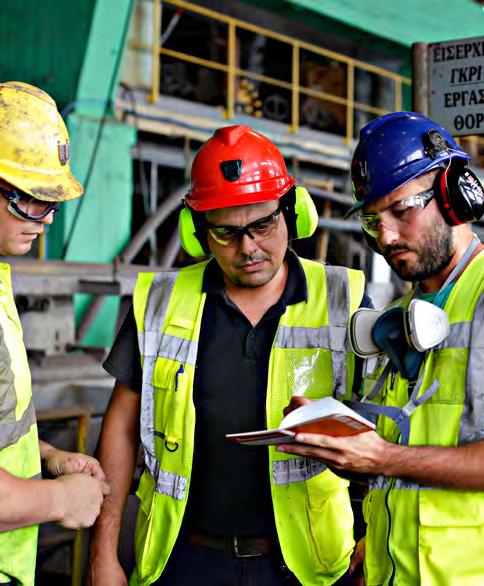4 minute read
2. Our Industry
Issue of Consideration
Trends in the Mining Industry
Mining companies face various challenges, from uncertain geopolitical landscapes to keeping up with the ongoing technology revolution, and the following important trends have been identified for the industry to leverage and navigate into the future: 1. The social investor – Embedding value beyond compliance into corporate DNA 2. Getting partnerships and joint ventures right –
Looking beyond structure to governance 3. Seize opportunity amid uncertainty – Why miners should prepare for the next downturn now 4. Dynamically managing risk – From risk registers to strategic risk management 5. The path to decarbonization – Miners’ role in reducing emissions 6. On the road toward intelligent mining – Reviewing lessons learned 7. Modernizing core technologies – Considerations around cloud, cyber, and revitalizing the core 8. The intersection of talent and community –
Proactively planning for the social impact of digital 9. Leadership in an Industry 4.0 world – Preparing to manage the mining workforce of the future 10. Tax tribulations – Concerns over ‘transfer mispricing’ put miners in the spotlight.
Source: Deloitte Insights, ‘Tracking the trends 2020: Leading from the front’
Mining Globally
Mining extracts essential metals and minerals from below the Earth’s surface, which are used for various goods to meet growing worldwide demands. As these metals and minerals do not have a functional role within the Earth’s ecosystem, removal itself does not have a significant negative impact on the ecosystem. However, removal process can have a significant impact and it is therefore essential to restore Earth’s surface for future uses. Mining companies must aim not only to generate positive returns for their shareholders, but also to make a real and lasting positive contribution to local communities. As a result, it is vital for companies to leverage their financial resources, technical expertise and supplier relationships to create a different and more sustainable future for mining.
Mining in Greece
Your View
The Mining Industry
According to a quantitative survey conducted in August 2019 to 500 members in the Municipality of Aristotle, 61% has a positive opinion about the mining industry.
Based on the Foundation for Economic and Industrial Research’s (IOBE) 2018 ‘Report on the mining industry’s contribution to the Greek economy’ (http://iobe.gr/ research_dtl.asp?RID=161), as well as the Greek Mining Enterprises Association’s 2017 Annual Report, the mining industry creates significant value for our national economy and more specifically: • 108,000 job positions • €2.4 trillion in industry potential • 3.1% in GDP share • €6 billion in state budget annually • €1.7 billion in new investments • €1.1 billion in exports (over 50% of total sales).
Mining Life Cycle
Our operations cover a broad range of the mining life cycle, from exploration and mining to reclamation and closure. The typical life cycle of a mining project expands from 25-50+ years through the following stages, which also include the current stages for our own mining sites.
Inputs
Resources and relationships
Exploration
Greece
Evaluation & Development
3–5 years 5+ years
Construction
Skouries
3–5 years
Mining & Processing
Olympias Stratoni 10–20+ years
Outputs
Gold, Silver, Lead Zinc, Copper
Reclamation & Closure
2–5 years
Exploration (3-5 years)
Includes identification of potential assets, along with assessment and evaluation of exploration projects, through geological surveys and sampling.
Evaluation and Development (5+ years)
Establishes air, water, soil and biodiversity baseline data through extensive environmental testing for the project’s Environmental Impact Assessment (EIA), which must be approved by the relevant authorities before a mine can be developed. The project’s social and environmental impacts are addressed through engagement and consultation with local communities, businesses and government throughout the environmental permitting process.
Construction (3–5 years)
Requires the majority of capital and resource inputs invested over the project’s life cycle, emphasizing local hiring and procurement, supporting local technical schools and universities, as well as training employees and workers (i.e. contractor employees) on environmental and health and safety practices, procedures and controls.
Mining and Processing (10–20+ years)
Includes ore mining, extracting and processing, with the leftover materials generated (e.g. waste rock, tailings) either placed in specially engineered storage and treatment facilities or reused on site for construction and reclamation activities. This phase requires extensive and comprehensive environmental monitoring to comply with environmental regulations and terms of operating permits and licenses.
Outputs
These are the products we produce, namely gold, silver, lead, zinc and copper, which are included in purchasing agreements with downstream refineries, defining quantity, quality and chemical composition parameters, as well as payment terms and conditions.
Reclamation and Closure (2–5 years, plus ongoing management)
The ultimate goal for each project is to restore environmental conditions in cases of environmental damage done by previous operators and restore land used by mining operations to its original state. While most of environmental rehabilitation and reclamation work is done after mine closure, respective activities are sometimes conducted alongside mining operations to reduce the size of disturbed land.
Care and Maintenance (indefinite, as appropriate)
At times, a project or mine can be placed into care and maintenance, either due to market price decreases or other obstacles (e.g. permitting delays at Skouries). During this phase, investments are made exclusively to keep equipment and facilities in working order, have permits in good standing and continue with environmental protection activities, which will allow operations to restart smoothly should conditions change.








